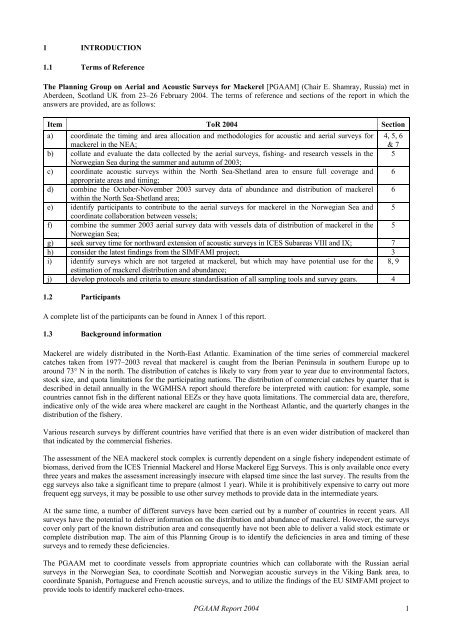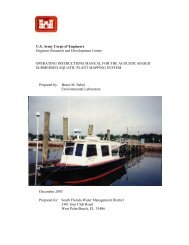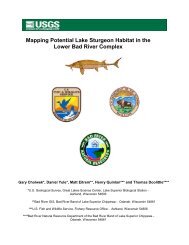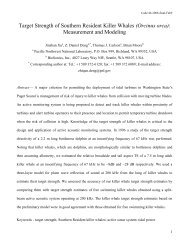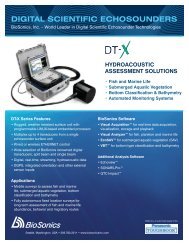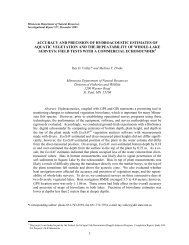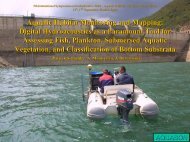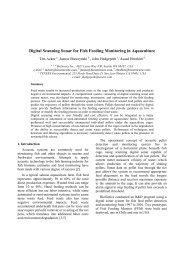Aerial and Acoustic Surveys for Mackerel - BioSonics, Inc
Aerial and Acoustic Surveys for Mackerel - BioSonics, Inc
Aerial and Acoustic Surveys for Mackerel - BioSonics, Inc
You also want an ePaper? Increase the reach of your titles
YUMPU automatically turns print PDFs into web optimized ePapers that Google loves.
1 INTRODUCTION<br />
1.1 Terms of Reference<br />
The Planning Group on <strong>Aerial</strong> <strong>and</strong> <strong>Acoustic</strong> <strong>Surveys</strong> <strong>for</strong> <strong>Mackerel</strong> [PGAAM] (Chair E. Shamray, Russia) met in<br />
Aberdeen, Scotl<strong>and</strong> UK from 23–26 February 2004. The terms of reference <strong>and</strong> sections of the report in which the<br />
answers are provided, are as follows:<br />
Item ToR 2004 Section<br />
a) coordinate the timing <strong>and</strong> area allocation <strong>and</strong> methodologies <strong>for</strong> acoustic <strong>and</strong> aerial surveys <strong>for</strong><br />
mackerel in the NEA;<br />
4, 5, 6<br />
& 7<br />
b) collate <strong>and</strong> evaluate the data collected by the aerial surveys, fishing- <strong>and</strong> research vessels in the 5<br />
Norwegian Sea during the summer <strong>and</strong> autumn of 2003;<br />
c) coordinate acoustic surveys within the North Sea-Shetl<strong>and</strong> area to ensure full coverage <strong>and</strong> 6<br />
appropriate areas <strong>and</strong> timing;<br />
d) combine the October-November 2003 survey data of abundance <strong>and</strong> distribution of mackerel 6<br />
within the North Sea-Shetl<strong>and</strong> area;<br />
e) identify participants to contribute to the aerial surveys <strong>for</strong> mackerel in the Norwegian Sea <strong>and</strong> 5<br />
coordinate collaboration between vessels;<br />
f) combine the summer 2003 aerial survey data with vessels data of distribution of mackerel in the 5<br />
Norwegian Sea;<br />
g) seek survey time <strong>for</strong> northward extension of acoustic surveys in ICES Subareas VIII <strong>and</strong> IX; 7<br />
h) consider the latest findings from the SIMFAMI project; 3<br />
i) identify surveys which are not targeted at mackerel, but which may have potential use <strong>for</strong> the 8, 9<br />
estimation of mackerel distribution <strong>and</strong> abundance;<br />
j) develop protocols <strong>and</strong> criteria to ensure st<strong>and</strong>ardisation of all sampling tools <strong>and</strong> survey gears. 4<br />
1.2 Participants<br />
A complete list of the participants can be found in Annex 1 of this report.<br />
1.3 Background in<strong>for</strong>mation<br />
<strong>Mackerel</strong> are widely distributed in the North-East Atlantic. Examination of the time series of commercial mackerel<br />
catches taken from 1977–2003 reveal that mackerel is caught from the Iberian Peninsula in southern Europe up to<br />
around 73° N in the north. The distribution of catches is likely to vary from year to year due to environmental factors,<br />
stock size, <strong>and</strong> quota limitations <strong>for</strong> the participating nations. The distribution of commercial catches by quarter that is<br />
described in detail annually in the WGMHSA report should there<strong>for</strong>e be interpreted with caution: <strong>for</strong> example, some<br />
countries cannot fish in the different national EEZs or they have quota limitations. The commercial data are, there<strong>for</strong>e,<br />
indicative only of the wide area where mackerel are caught in the Northeast Atlantic, <strong>and</strong> the quarterly changes in the<br />
distribution of the fishery.<br />
Various research surveys by different countries have verified that there is an even wider distribution of mackerel than<br />
that indicated by the commercial fisheries.<br />
The assessment of the NEA mackerel stock complex is currently dependent on a single fishery independent estimate of<br />
biomass, derived from the ICES Triennial <strong>Mackerel</strong> <strong>and</strong> Horse <strong>Mackerel</strong> Egg <strong>Surveys</strong>. This is only available once every<br />
three years <strong>and</strong> makes the assessment increasingly insecure with elapsed time since the last survey. The results from the<br />
egg surveys also take a significant time to prepare (almost 1 year). While it is prohibitively expensive to carry out more<br />
frequent egg surveys, it may be possible to use other survey methods to provide data in the intermediate years.<br />
At the same time, a number of different surveys have been carried out by a number of countries in recent years. All<br />
surveys have the potential to deliver in<strong>for</strong>mation on the distribution <strong>and</strong> abundance of mackerel. However, the surveys<br />
cover only part of the known distribution area <strong>and</strong> consequently have not been able to deliver a valid stock estimate or<br />
complete distribution map. The aim of this Planning Group is to identify the deficiencies in area <strong>and</strong> timing of these<br />
surveys <strong>and</strong> to remedy these deficiencies.<br />
The PGAAM met to coordinate vessels from appropriate countries which can collaborate with the Russian aerial<br />
surveys in the Norwegian Sea, to coordinate Scottish <strong>and</strong> Norwegian acoustic surveys in the Viking Bank area, to<br />
coordinate Spanish, Portuguese <strong>and</strong> French acoustic surveys, <strong>and</strong> to utilize the findings of the EU SIMFAMI project to<br />
provide tools to identify mackerel echo-traces.<br />
PGAAM Report 2004 1


